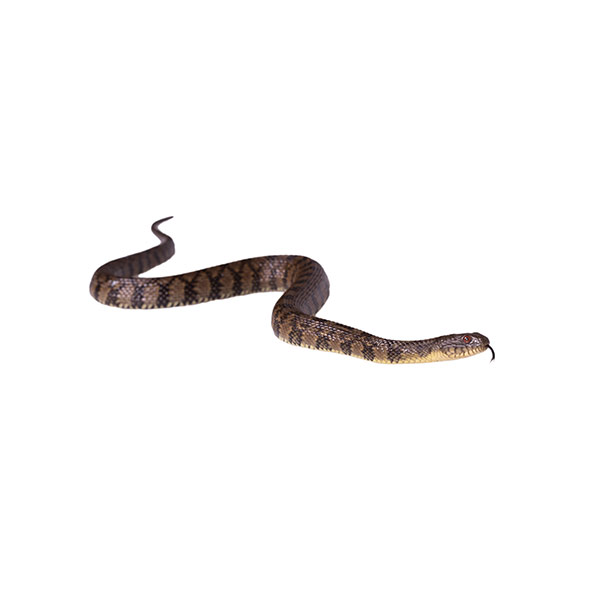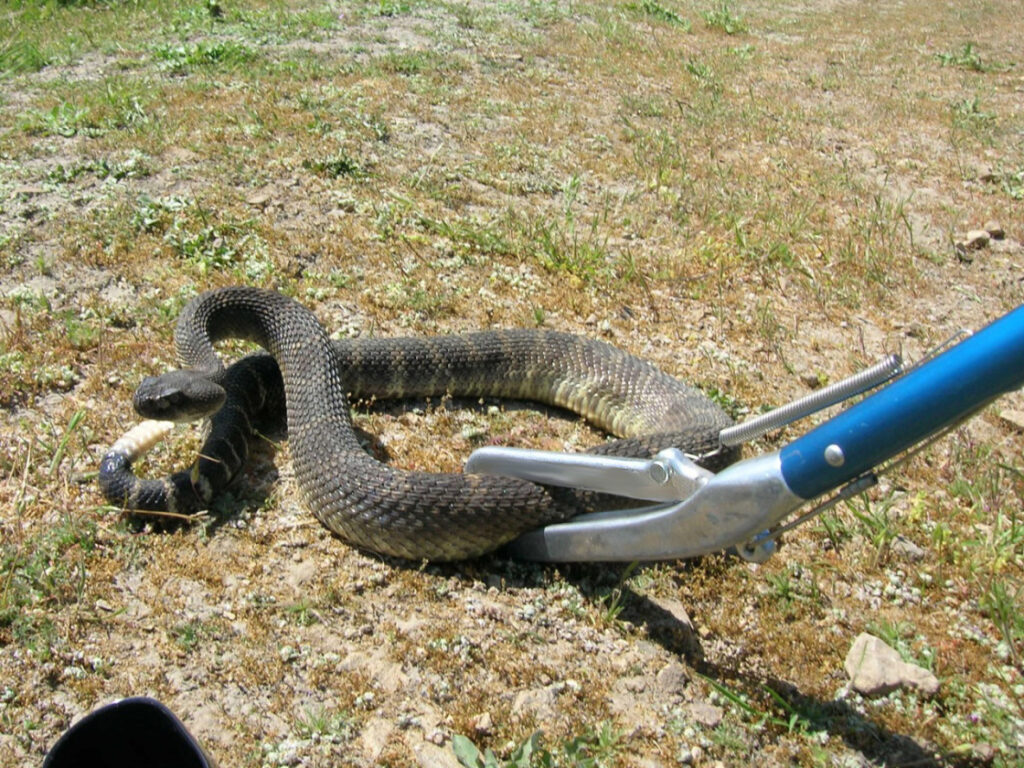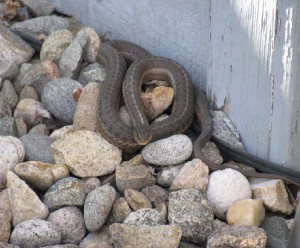IDENTIFYING A SNAKE INFESTATION
It can be very difficult to realize that you have snakes on your property until the problem becomes more severe. Snakes will typically hide in confined spaces, avoiding contact with humans. We often find snakes living in crawlspaces, walls, gardens, decks, and any overgrown vegetation surrounding the property.
Snakes do leave behind a few signs of their presence. They can cause damage to structures, where they have created their nests. You may also realize that you have a snake problem if you see snakeskin in your yard or within your house
Many homeowners, unfortunately, discover that they have a snake infestation when they are face to face with a snake. If you do see a snake, give it space and call a professional as soon as possible
Banded water snakes are nonvenomous snakes that are commonly mistaken for cottonmouth snakes. These snakes have heavy bodies with both dark markings and lighter colored scales. Banded water snakes can grow up to three feet long and have broad, flat heads, which is another characteristic that gets them mixed up with cottonmouth snakes so often.
BANDED WATER SNAKE BEHAVIORS
As their name suggests, these snakes prefer to live in or near water—they are even known to be one of the strongest swimmers out of all types of snakes. It’s important to note they are typically found in fresh water sources, including lakes and ponds. While they aren’t aggressive, banded water snakes aren’t particularly friendly and will avoid contact with humans at all cost. When threatened, they may release an unpleasant odor or even bite; although their bite is not venomous it can still be quite painful.

How to Get Rid of Snakes
NOTE: If venomous snakes are a known issue on your property, we strongly recommend you consult with a professional wildlife removal company prior to any snake inspection or removal efforts.
You can use snake tongs to catch live snakes and physically remove them from a given area. We highly recommend you practice with a rubber snake or piece of hose prior to trying catch a live snake with the tongs. Snake tongs come in varying lengths. While the longer length tongs will keep you further away from the snake, they are heavier and a little hard to manipulate. When trying to grab a snake with tongs, you want to aim for about 1/3 of the way down the snake’s body. Grab too close to the snake’s head and you risk injuring the snake and also causing it to struggle and possibly try to escape. Grab too far to the back end and the snake may wind up in striking distance. Once you have grabbed the snake with the tongs you should carefully and slowly lift the snake while keeping the tail of the snake on the ground and gently drag it towards the area you intend to let it go or dispatch it. If you lift the snake all of the way it will likely struggle to get away.
Pros and cons: Snake tongs can be used anywhere on your property and inside the structure which makes them very versatile. The downside is that you must come pretty close to snake in order to capture them with tongs.
The second method of capturing snakes that we would recommend is the use of snake glue board traps. Some snake glue boards such as the Cahaba brand can be used outdoors next to the foundation or under structures or in gardens. Other snake glue boards are less hardy and should only be used indoors. Snake glue boards do not contain any bait or lures. This means that the glue boards will only be effective if they are used in areas where snakes are known to frequent or use as travel paths.
Outdoors you should place the cahaba snake boards in shaded areas in gardens, near foundations, under sheds or other structures, along fence lines and other areas you have noticed snakes frequently. It is important to note that snakes like to travel with one side of their bodies touching against a vertical surface and you should place your boards so that the snake slithers into the glue board. Snake traps should be checked often if you plan to live release snakes that are captured

Snakes and Toads Provide Garden Pest Control
Encountering a snake in the garden causes many people to shriek or even panic. Yet snakes and another often unloved creature, the toad, are among the most effective forms of pest control. If you tolerate these herpetological visitors – or better yet, encourage their presence – you’ll be less likely to share your garden with ravenous bugs, or bottles of pesticide.
There are several snakes that make themselves at home in local gardens. The common garter snake is identifiable by the three yellow stripes running along the back. In my garden, this snake often suns itself between rows of vegetables, absorbing heat while digesting slugs, caterpillars, sowbugs, and other garden pests. Larger garter snakes (they can grow about three feet long) also eat meadow voles, which will otherwise wreak havoc on roots, tubers, and bark.
My favorite snakes are among the most docile encountered in a garden: the smooth green snake and ring-necked snake. The grass-hued scales of the green snake blend in well. Almost three fourths of its diet consists of insects, including grasshoppers, hornworms, and other crop-munching caterpillars. The ring-necked snake, named for its golden collar, stalks similar prey, but it does so under the stars. With a back the color of night, and its bright yellow belly pressed to the earth, it’s well camouflaged for nocturnal hunting
In contrast, the milk snake strikes when threatened. Although non-venomous, the milk snake’s attitude, size (it grows to three feet long) and rows of alternating reddish-brown splotches, which resemble the patterning of a copperhead or timber rattlesnake, have earned an undeserved reputation and the misnomer of “adder.” In fact, it is harmless to all but the mice, voles, other small mammals and other snakes that comprise up to 70 percent of its diet.
You can attract snakes to your garden by providing habitat: loose rock piles, old tree stumps, brush piles, prone boards, a stack of wood, and unkempt corner swales. And since pesticides can sicken and kill reptiles and amphibians, maintaining a chemical-free garden safeguards these natural predators.

Snake Control
Non-Poisonous Snakes Identification and Description
Despite their reputation for the contrary, most snakes in the United State are not poisonous. In fact, of all the many species in the country, only a few are actually potentially harmful; rattlesnakes, copperheads, cottonmouths, coral snakes, and sea snakes.
For the most part, snakes aren’t highly adaptable creatures and require a specific habitat in order to survive. Smaller species often live underground, while others, like green snakes make their homes in trees. In generalities, snakes prefer dark, cool and damp places where food is readily available.
Although there isn’t an absolute pattern for snake infestations, there are areas that seem to be more attractive than others. Firewood that is stacked directly on the ground, old lumber piles, flower beds and gardens with an excess of mulch, disorderly basements, junk piles and barn lofts. Barn lofts are especially appealing when stored feed attracts rodents, as are attics with rat or mice control problems. Pond and river banks–especially when there are boards, tires and other items in the surrounding area, additionally with unmowed lawns and abandoned lots are also alluring to snakes.
Diet and Feeding Habits
Every snake is a predator, but diets may widely vary depending on the species. Rat snakes for example, as their name would indicates, eat primarily rodents, baby birds and eggs. Some snakes eat primarily insects, while other smaller species, like earth snakes and worm snakes, eat earthworms, slugs, and salamanders. Water snakes eat primarily frogs, fish, and tadpoles.
Damage Possibilities
Aside from frightening people, nonpoisonous snakes are completely harmless and tend not to cause damage. Once a snake or a group of snakes is identified as non-poisonous, most methods for removal are inexpensive and fairly non-invasive.

Snake Removal
When Snakes Get Into Your Home
Snake are generally quite sensitive to a human’s presence so when they get into your home, they’re not easy to spot or even realize they’re there. But once you do see one, it will surely cause a concern.
Although the majority of snakes are completely harmless, there is the possibility that the snake you’ve encountered is one of the venomous types, of which means you need to take the proper precautions for the sake of the safely of your family and pets. An encounter with a snake is not worth the cost of getting bit by a dangerous one. One of the most common areas snakes enter homes is through the openings in weeping bricks. A good percentage of the time that, and open doors are their entry points
A snake problem calls for the help of an experienced removal specialist to ensure all precautions are taken, that the snake is handled and removal humanely, and that effective prevention and control methods are devised and properly implemented.
There are some key reasons that should prompt you to hire us for a snake removal job, and they are because:
if you encounter a Mississauga rattlesnake in your home, you’re immediately at risk of being bit by it’s venomous fangs
they post more serious threats to pets and children
if they are in your home because of a food source like mice or birds, they may end up carrying bacteria with them to other places of your home
regardless of species, you can get bitten, and may require medical attention
they may sleep in areas where we put our feet or step on, and severely frighten a family member
Snakes don’t particularly like to live near humans but if they accidentally make their way into your home or basement, they may need some help leaving. Snakes also hibernate in the winter and at those times are rarely seen. But come spring, they start slithering about, and are looking for the way to the front door. Sit back and let us help them get there.